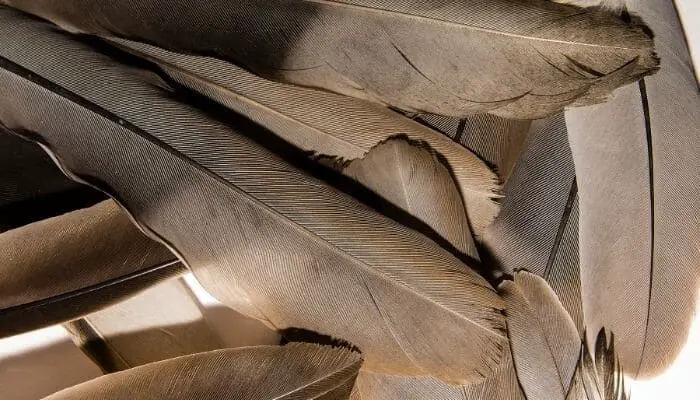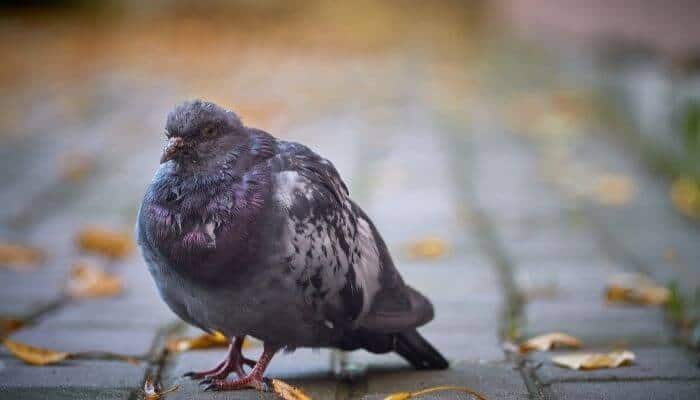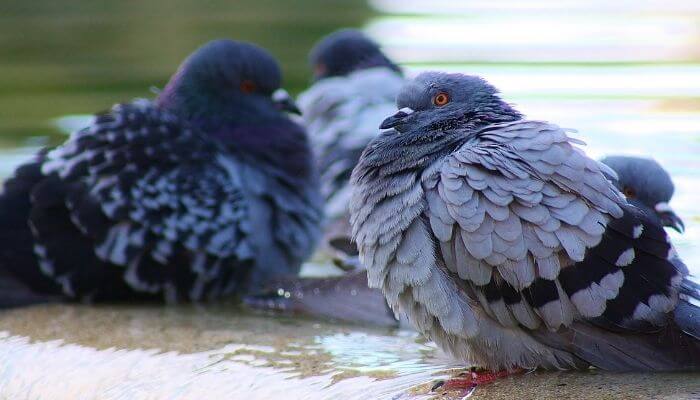Pigeons moult feathers and it is an important stage in their life cycle. The more you know about it, the better you will be able to take care of your birds as it is happening.
Here is a comprehensive guide to everything pigeon moulting related.
What Is Pigeon Moulting?
Pigeon moulting is defined as the period every year in which the feathers on your bird are renewed.
This includes the head, neck, cover feathers, wing bars, thumb feathers, all ten primaries on each wing along with the twelve secondaries, and the feathers that cover the rail and rump.

Something to keep in mind is that the smaller, less ‘significant’ feathers on your pigeon will moult almost all year round, and this is down to the way that it has been bred.
This ‘lesser’ period of moulting is usually considered to be complete after about two years, and your pigeon will preen and peck these feathers until the job is done.
This is a different kind of moulting to the extensive annual moult that we are talking about here, so let’s dive a little bit deeper into the facts.
When Does Pigeon Moulting Happen?
In one of those perfectly delicate processes of nature, pigeon moulting has a defined set of dates in which it occurs with almost exact precision.
Generally, the moulting period for a pigeon is something that begins in August and continues all the way through until mid-November.
This timing is to ensure that the bird grows new strong, warm feathers that are going to help see them through the winter in the best and most comfortable way.
In total, a pigeon tends to need between 160 and 170 days to completely begin and finish its moulting process.
From the moment that the first feather falls from its body, the clock is on, and more than just a change of feathers occurs during this time.
The pigeon’s body goes through a lot of changes during the moulting process, some of which aren’t actually visible to the naked eye like the actual moulting itself.

Moulting drains the pigeon of resources.
Along with the feathers, the bird loses large amounts of keratin and sulphurous proteins, so it is really important that you increase the supply of protein-packed feed during the moulting period.
What Are the Benefits of Pigeon Moulting?
The most significant benefit of moulting for pigeons (in the Western Hemisphere) is the fact that they receive a new, fresh, strong and warm coat of feathers that helps to guard them against the colder winter temperatures that come around after the mid-November end date.
Moulting gets rid of worn-out feathers.
Older feathers affect a racing bird’s flight and performance so racing pigeon owners should pay particular attention to the moulting process.
Moulting is also a “makeover” process. Birds still need attraction for mating and breeding so any pigeon with old feathers is going to be less attractive to the opposite sex than a newly moulted bird.
Does Pigeon Moulting Have Different Effects on Different Feathers?
The different sections of a pigeon will moult and visibly change in different ways, so don’t get anxious if parts of the bird look different from the rest at various stages over the course of the process.
The general aim is for the pigeon to achieve a full set of new, smooth feathers, and that is the key sign of a healthy moult.
The two things that you can do to make sure that each feather group ends up being as smooth and as healthy as possible are in the protein-filled feed that you provide your bird during this time, and the regular bathing that you can encourage in order to help the feathers and downfall away in a gentle and healthy way.
Something to look out for in terms of visual feather differences is fret marks.
Fret marks are common flaws that occur as a sign of hard flight, where your bird has used up all of its energy reserves to fly which causes a shortage of nutrients needed to aid the healthy moulting process.
If your pigeon is engaging in hard flight during the moulting period, then fret marks may be left in the pattern of their feathers. Many regard these as battle scars!

This article was written by our qualified veterinarian Cristina.
This is part of our commitment to providing you with the most trustworthy veterinary advice for your pigeons.
How Do You Ensure a Good Moult?
One of the most effective ways to assess whether your pigeon has experienced a ‘good’ moult is by examining its tail. You will be able to tell if your bird has experienced an ideal moult if its tail feathers do not contain any small holes.
The hollow shafts should not be split and should not have any nodes, and when the moulting process has finished naturally and successfully, the general colour of the pigeon’s body should be visible about one centimetre behind the darker wing bar.
The Relationship Between Moulting and Bathing
You definitely want to maintain a weekly bath routine with your pigeon, even when it is in the stages of moulting.
During very hot summers, some owners even go as far as bathing twice a week.

If you have a pigeon that is very wilful and does not like taking or receiving a regular bath, then you have to take your ownership responsibility seriously and put your foot down!
The most important thing to remember with regards to bathing is that a good bath can actually help to strengthen the organs of the pigeon, along with the obvious benefit of removing the dirt from their feet and feathers.
Moulting During Training and Impact on Racing Pigeons
When you are an ambitious pigeon racing enthusiast, it can be very tempting to push the boat out and train your birds as hard as you and they can go all year long, but to ensure a healthy moult it is best to keep to a slower pace during the most intense periods of the moulting process.
The facts are that a pigeon will actually moult slower if they are forced to train for too long.
During their periods of heaviest moulting, the recommended schedule is something along the lines of letting the pigeons out for a fly around your loft once every day, along with encouraging them to have a bath maybe two times a week.
In terms of racing performance, it’s actually a case of choosing to believe one thing over another, because there are lots of different and varying opinions within the community.
There are pigeon fanciers who firmly believe that long-distance racers moult later in the season compared to sprinters, and others will tell you that pigeons that moult quickly are weaker birds.
The Impact of Moulting on Show Birds
When it comes to show birds, the main thing that owners want to ensure is that their pigeons have completed their moulting process before their show season is set to take place.
Ideally, you do not want to present a bird that is only halfway through a moulting cycle, because, quite simply, they just don’t look their best!
Would you like to present yourself in a competition wearing half your clothing and showcasing a severe case of bed hair? No, we didn’t think so, and neither would any of us either!
Sources:
